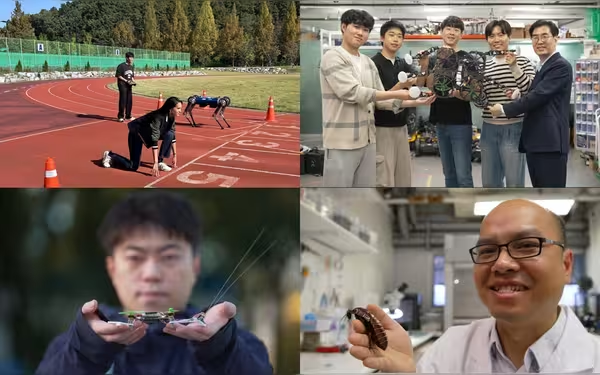Saturday, November 16, 2024 05:59 PM
Life-Saving Robotics Innovations Inspired by Nature
- KAIST develops DreamWaQ for blind navigation.
- Delft University creates microdrones inspired by ants.
- University of Queensland explores insect-machine hybrids.
 Image Credits: prnewswire_apac
Image Credits: prnewswire_apacExplore groundbreaking life-saving robotics inspired by nature, enhancing human assistance in critical situations.
In recent years, the field of robotics has seen remarkable advancements, particularly in technologies inspired by nature. This innovative approach is not only transforming the way we think about machines but also enhancing their capabilities to assist humans in critical situations. The latest episode of "Tech for Good" on CNN highlights some of these groundbreaking developments, showcasing how students and professors worldwide are creating life-saving robots that mimic the natural world.
One of the standout innovations comes from the Korea Advanced Institute of Science and Technology (KAIST), where researchers have developed a robot controller technology known as "DreamWaQ." This advanced AI system is designed to help blind individuals navigate various terrains safely. By utilizing deep learning techniques, DreamWaQ can potentially play a crucial role in search and rescue missions, especially in challenging environments like fires or disasters where visibility is severely limited. Additionally, this technology has been integrated into the Hound 2, a quadruped robot that holds the Guinness World Record for the fastest 100-meter sprint. This exciting development not only showcases the potential of robotics but also highlights the playful side of technology as Kristie Lu Stout challenges the Hound 2 on the racetrack.
Another fascinating project from KAIST is CAROS-H, a wall-climbing drone inspired by six-legged insects. This drone can both fly and walk, demonstrating the versatility of robotic designs that take cues from nature. Meanwhile, in the Netherlands, scientists at Delft University of Technology (TU Delft) are making strides in micro-robotics. Their Micro Air Vehicle (MAV) Lab has created microdrones that navigate using "odometry," a method inspired by ants that allows these tiny machines to track their movements with minimal processing power. This efficiency is crucial for developing drones that can operate in complex environments.
Moreover, researchers at TU Delft's Biomorphic Intelligence Lab are working on biomorphic whisker sensors that enable drones to navigate in the dark, drawing inspiration from the sensory capabilities of animals, including a professor's pet rabbit. This blend of biology and technology is paving the way for more intuitive and capable robotic systems.
In Australia, the University of Queensland is exploring the concept of insect/machine hybrid robots. By attaching miniature control backpacks to living insects, researchers aim to harness their natural mobility and adaptability. This innovative approach could lead to low-cost and energy-efficient solutions for search and rescue operations, particularly in confined spaces where traditional robots may struggle.
As we look forward to the season finale of "Tech for Good," set to air on November 30, 2024, it is clear that the intersection of technology and nature is not just a trend but a vital area of research that holds the potential to save lives. The projects featured in this series exemplify how innovation can be driven by the natural world, leading to advancements that could significantly impact our future.
The developments in life-saving robotics inspired by evolution are not only fascinating but also essential for addressing real-world challenges. As technology continues to evolve, it is crucial to remember the lessons nature has to offer. By looking to the natural world for inspiration, we can create solutions that are not only effective but also sustainable, paving the way for a brighter future where technology and nature coexist harmoniously.













